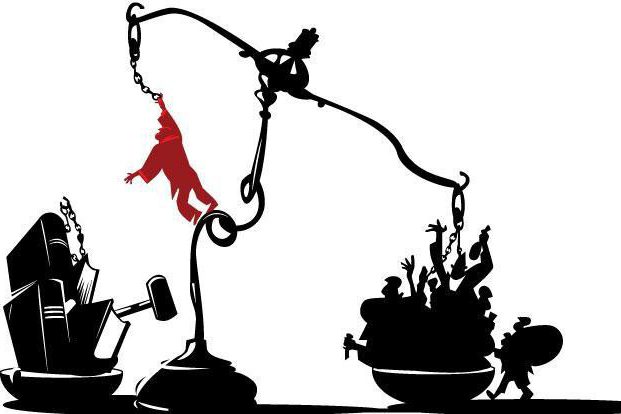Law enforcement requires careful reflection and a deep understanding of the rule of law that must be implemented. The very choice of one or another article of the law implies an initial understanding of its content. Intellectual activity to explain and comprehend regulatory requirements is called “interpretation of the rule of law”. The concept, types, methods of it - you will learn about all this from the article.
Interpretation of the rule of law: concept

The term “interpretation” is very ambiguous. In a broad sense, it is understood as any process of cognition that is aimed at explaining social or natural phenomena. In a narrower understanding, interpretation is nothing more than an explanation of symbols, formulas, expressions, i.e., signs of an artificial and natural language. In addition, under this term combine the totality of meanings (values) that are attached to them. Thus, on the one hand, it is a thought process, and on the other, its result.
The concept and methods of interpretation of the rule of law are evaluated in legal science in a similar way. On the one hand, this term implies a certain intellectual process, which is aimed at establishing the content of legal norms by identifying the meaning and meanings of expressions and terms contained in regulatory enactments. And at the same time, interpretation is understood as the result of this activity. He finds expression in the totality of language utterances that reflect the content of legal norms. This can be fixed in an official act adopted by state bodies or in the form of individual advice, recommendations given by public organizations that are not formally binding.
Interpretation and Lawmaking

It should be noted that the concept, necessity and methods of interpretation of the rule of law are closely interconnected with lawmaking, but the processes differ from each other. Anyone who provides an interpretation of a legal norm is not its creator. He only finds out, establishes the popular will, which is reflected in the normative act. The subject of research in interpretation is only the rule of law. In no case does the interpreter have the right to go beyond it; he must observe a strict regime of legality. To carry out this activity, there are various ways, methods of interpretation of the rule of law, which are discussed further in the article.
Due to its abstractness, legal norms can take into account not only the facts foreseen by the legislator, but also newly discovered (not taken into account by him) situations. Therefore, interpretation is always painstaking, active and even creative activity. The interpreter must actively put into practice his experience and knowledge. The interpretation should not go aside from the imperative of the law, try to expand or narrow the meaning of the rule of law or change it, it only comprehensively examines it and clarifies the meaning that is embedded in the wording of the legislator. In this regard, the interpreter must have knowledge of different aspects of society, well versed in the specifics of public relations.
Interpretation of the rule of law: goals
All methods of interpretation (clarification) of the rule of law known to modern legal science are aimed at achieving one main goal - understanding their meaning, but not just from the abstract side to solve academic problems, but in order to solve life conflicts on the basis of this. This activity is one of the means of strengthening the rule of law in a state.
Insufficiently correct and deep interpretation of legal norms and, as a consequence, their application can lead to serious errors and consequences when translating the provisions of the law into practice. It should be aimed at achieving the following goals:
- accurate, correct and, what is important, uniform understanding and practical application of laws;
- revealing the essence of the law, which the legislator has put into the verbal wording of the legal norm.
Unfortunately, goals are not always achieved in practice. It happens that a big politics is “included” in the interpretation process.

Types of interpretation of the rule of law
In literature, the classification of interpretation of the norms of the right to species is considered recognized in its legal force, scope of action and degree of specification. We consider each of them in more detail below, and only then we will focus on the methods.
The types of interpretation of the rule of law are as follows:
- legal force: unofficial and official interpretation; the first is further divided into competent (doctrinal and professional) and ordinary, and the second - into authentic and legal;
- by degree of specification: casual and normative interpretation;
- by volume: literal (adequate), widespread and restrictive interpretation.
It is logical to first pay attention to species, and only then consider ways of interpreting the rule of law. In terms of volume, as already indicated above, it implies three types: distribution, adequate and restrictive. Let's consider each of them in detail, with an example.
Literal interpretation
An adequate, or literal, interpretation reveals the actual (real) content of legal norms, which corresponds to the "letter" of the law, its text. As an example, we cite article 19 of the Federal Law "On Mortgage", the text of which states: "Mortgage is subject to state registration in the USRN." No matter how you “twist” this wording, what methods of interpretation of the rules of law you use, its actual content has a strictly defined character that exactly matches the language expression. According to the well-known rule, well-developed laws are interpreted exclusively literally.
Spreading interpretation

Under the distribution refers to the interpretation of legal norms, according to which the disclosed content of the rules is ultimately wider than the literal text of the law. Let us turn to the Civil Code of the Russian Federation, in the second part of Article 344 of which it is stated: “The pledge holder is responsible for the full or partial loss or damage of property transferred to him”. This text should not be understood literally, but more broadly. So, “loss” can mean not only death, but also self-destruction, as well as other cases of the cessation of the existence of property. The methods of interpretation of the rule of law may be different.
Restrictive interpretation
With a restrictive interpretation, we observe the opposite picture. The effective content of the norm “already” revealed as a result of it than the literal text. For example, many legal acts refer to so-called force majeure. This expression is interpreted in a narrower sense. It is understood as an “insurmountable” circumstance, but not in moral, psychological or social significance, but only in terms of natural and natural phenomena that cannot be prevented even with normal modern life activities of society.
Legal Interpretation

The official interpretation is regulated normatively and the acts of interpretation created as a result are legally binding. Such powers are possessed by the president of the Russian Federation, the government and parliament, as well as similar structures of the country's subjects. In addition, the courts of the Russian Federation participate in this activity, the Constitutional carries out an official interpretation of the Constitution, the Supreme Arbitration and the Supreme clarifies issues of judicial practice.
Unofficial interpretation of legal norms is carried out by lawyers, scientists, lawyers, public organizations, individual citizens. It “enriches” the official interpretation with a unity of views, approaches and qualified implementation in practice.
Interpretation
According to the degree of specification, the interpretation can be casual and normative. In the first case, this refers to the official clarification by the competent authority of the essence of the rule of law. It is mandatory for all bodies and persons that directly fall under the jurisdiction of the interpreter. In addition, it extends its effect to the whole range of cases that are provided for by a legal norm, and thereby ensures the correct and uniform implementation of prescriptions.
A casual interpretation is given by the court and other competent authorities in connection with and in connection with the consideration of a particular case. It has no binding force.
Next, after the views along the hierarchical chain, there are techniques or methods of interpretation of civil law. With their help, the thought process is carried out.
Grammar way
The grammatical (textual, philological) way of interpreting the rule of law as an object of study considers the text, that is, the external side. It turns out in what formulations and sentences, words lies the sanction and disposition of the norm. To do this, it is necessary to establish the meaning of individual words, find out their grammatical form and determine the relationship with other parts of the sentence. Further, the semantic and grammatical load of the sentences that make up the rule of law is clarified.
Considering the methods of interpretation of the rule of law as a structure, it can be noted that the grammatical device is the original, primary. No wonder there is an expression: "First there was a word." Legal norms can exist only in linguistic form and are always expressed in the text of a normative document. Therefore, when considering the laws and methods of their interpretation, there is always a difference between the "letter" and the "spirit", that is, the literal text and the actual content.
Logical and legal way

Tacitly distinguish between the methods of interpretation of the rule of law primary (source) and secondary. The first include grammatical and logical-legal techniques. They rely on the text of the law and do not go beyond it. When interpreting the rule of law on the material of the norm itself, various methods are used: analogy, arguments from the contrary, reduction to absurdity, transformation of sentences, etc.
The rules and laws of formal logic make it possible to rise one more step higher to the correct disclosure of the content of the law. The thought of the legislator is expressed not only through grammatically correct sentences, but also through logical organization and construction. Law in itself is a formal logical phenomenon, where the determining principles are logical harmony, consistency, consistency and completeness.
Systematic way
Ways of interpreting the rule of law would be incomplete, incomplete without a systematic admission. It is he who helps to understand the meaning of one separate norm from the point of view of its relationship with others and to determine its place in the system of a normative act. A systematic interpretation contributes to several goals. Firstly, the disclosure of the meaning of a legal norm, depending on what place it occupies in a normative act or code. Secondly, the relationship is established. The legal norm under study is compared with others from the given branch of law and from other blocks with which it, in one way or another, “intersects”.

For example, the Criminal Code of the Russian Federation contains article 143, which provides for the employer's responsibility for violation of the rules regarding labor protection issues. However, there is no clear indication in what exactly they can be expressed.There are quite a few such rules; they are enclosed in other laws, rules, standards, etc. This interpretation should be taken into account in the interpretation. The establishment of systemic relations between the individual norms promotes a correct understanding of the scope of their action, the circle of persons they concern, the meaning of a term, etc.
Historical target method
Under the historical and targeted way of interpreting norms is meant the study of the historical situation that prevailed at the time of their publication, the tasks that the legislator faced, the establishment of their social significance on the basis of the processes taking place in society, which determined their emergence and implementation.
When applying this technique, various materials and documents published in the media, literature reflecting the country's policy on a specific issue are used. The historical and political interpretation allows in each historical period to approach correctly and differentially the understanding of a particular word, term, concept.
Both primary and secondary methods of interpretation of the rule of law are used in a complex, in aggregate. The above techniques always determine and complement each other. When interpreting a particular norm, they always resort to them simultaneously and in parallel.